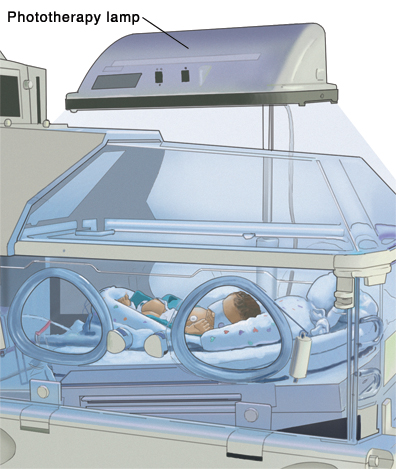Phototherapy for Newborn Jaundice
Phototherapy for Newborn Jaundice
Jaundice is a yellowing of the skin and the whites of the eyes. It comes from a yellow substance called bilirubin. Bilirubin is produced when red blood cells break down. It is processed by the baby’s liver. It then leaves the body through the baby’s urine and stool. If babies aren't eating and stooling very much, it is harder for them to get rid of bilirubin.
Bilirubin makes the skin and the whites of the eyes look jaundiced (yellow). This process is normal after birth because babies' red blood cells break down more easily and their livers are less mature. In fact, about half of all newborns have jaundice in their first week of life. It’s usually temporary and doesn’t require treatment. But in some cases, more severe or pronounced jaundice is a sign that the baby’s body can’t process bilirubin quickly enough. If bilirubin levels become too high, they can be dangerous to a baby's developing brain and nervous system. In these cases, phototherapy is needed. This treatment helps speed up the breakdown of bilirubin by changing it into a form that can leave the body in the urine rather than the stool. This process is called photoisomerization.
How it works
The baby is placed under a special light. This changes the form of the bilirubin in the skin. During treatment, the baby’s eyes are covered for protection and comfort. The rest of the body is naked, except for a diaper. This way the light reaches most of the skin. The baby’s position will be changed often to make sure all of the skin is exposed to the light.
How long will phototherapy be needed?
Phototherapy may be needed for a few days to a week. You will probably be asked to limit the amount of time the baby spends out from under the lights. The baby can usually be held for feedings if the level of jaundice is not too high. Fluids may be given through an IV (intravenous) line. These cause the baby to urinate more often, so the bilirubin leaves the body more efficiently. Some babies can go home from the hospital and receive phototherapy with special home phototherapy systems.
Updated:
September 30, 2017
Sources:
Bhutani, VK. Phototherapy to Prevent Severe Neonatal Hyperbilirubinemia in the Newborn Infant 35 or More Weeks of Gestation. Pediatrics 92011); 128(4); s1046-s1052, Treatment of unconjugated hyperbilirubinemia in term and late preterm infants. UpToDate.
Reviewed By:
Freeborn, Donna, PhD, CNM, FNP,Image reviewed by StayWell medical illustration team.,Lee, Kimberly G., MD, MSc, IBCLC
